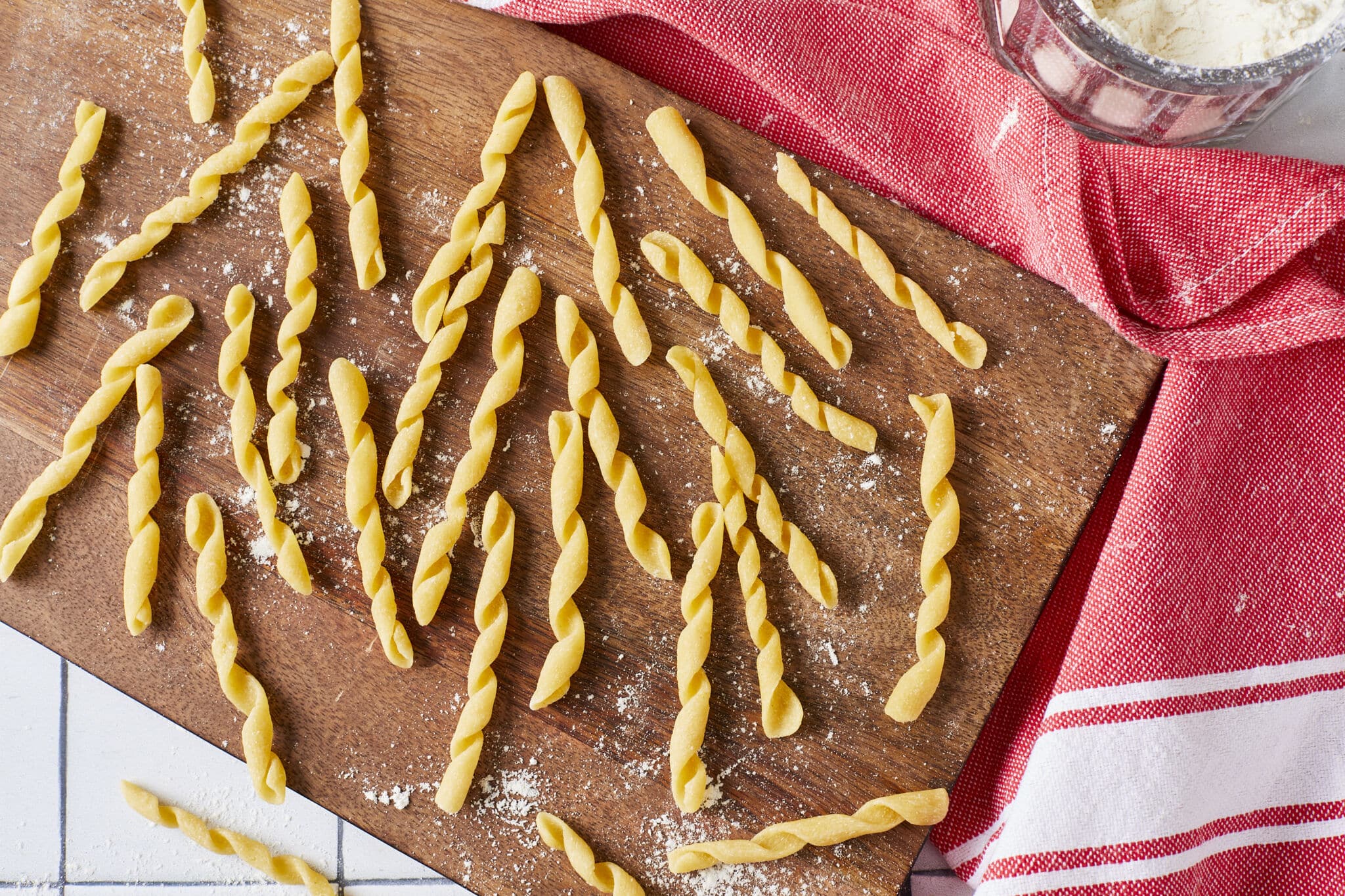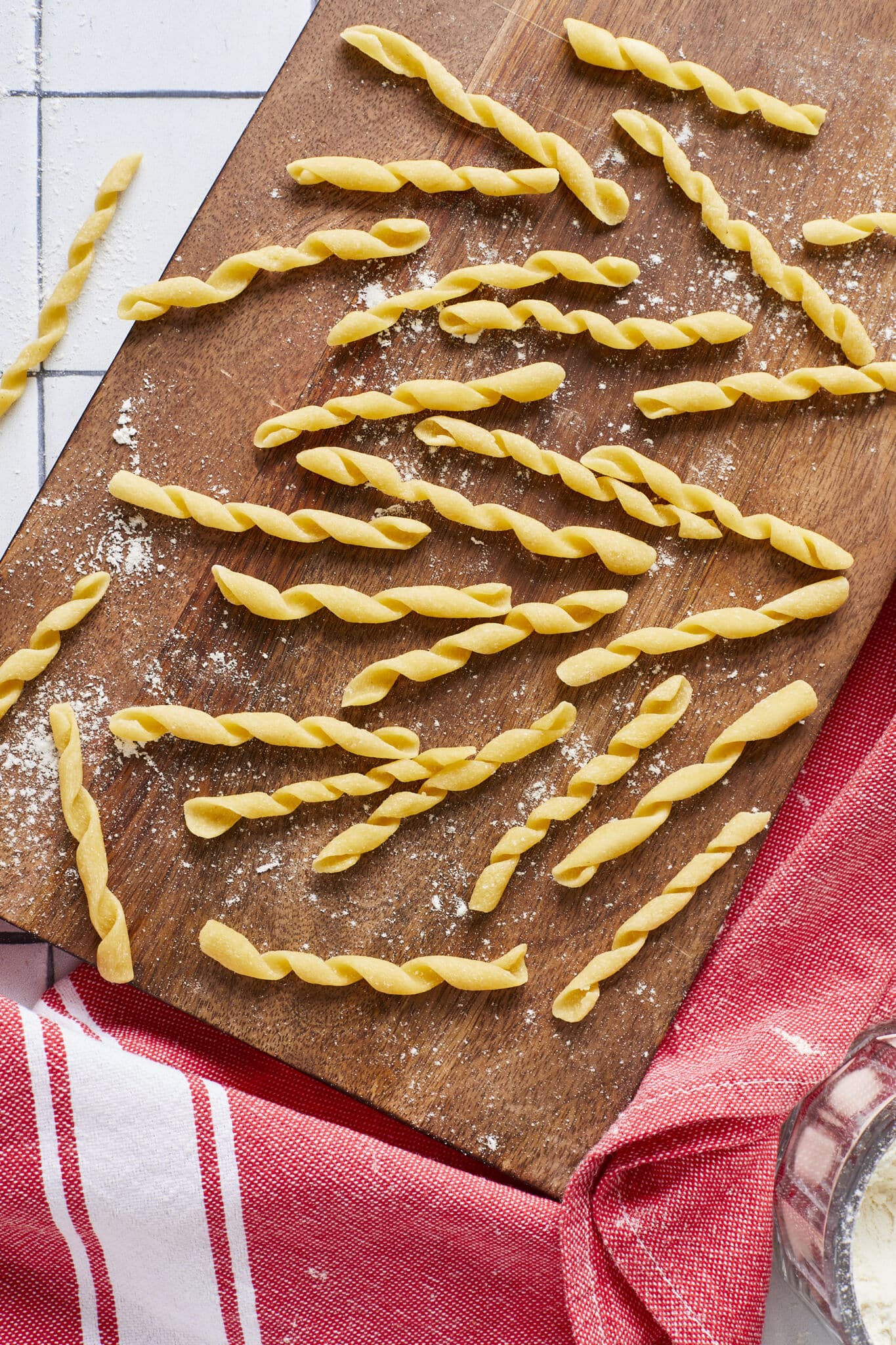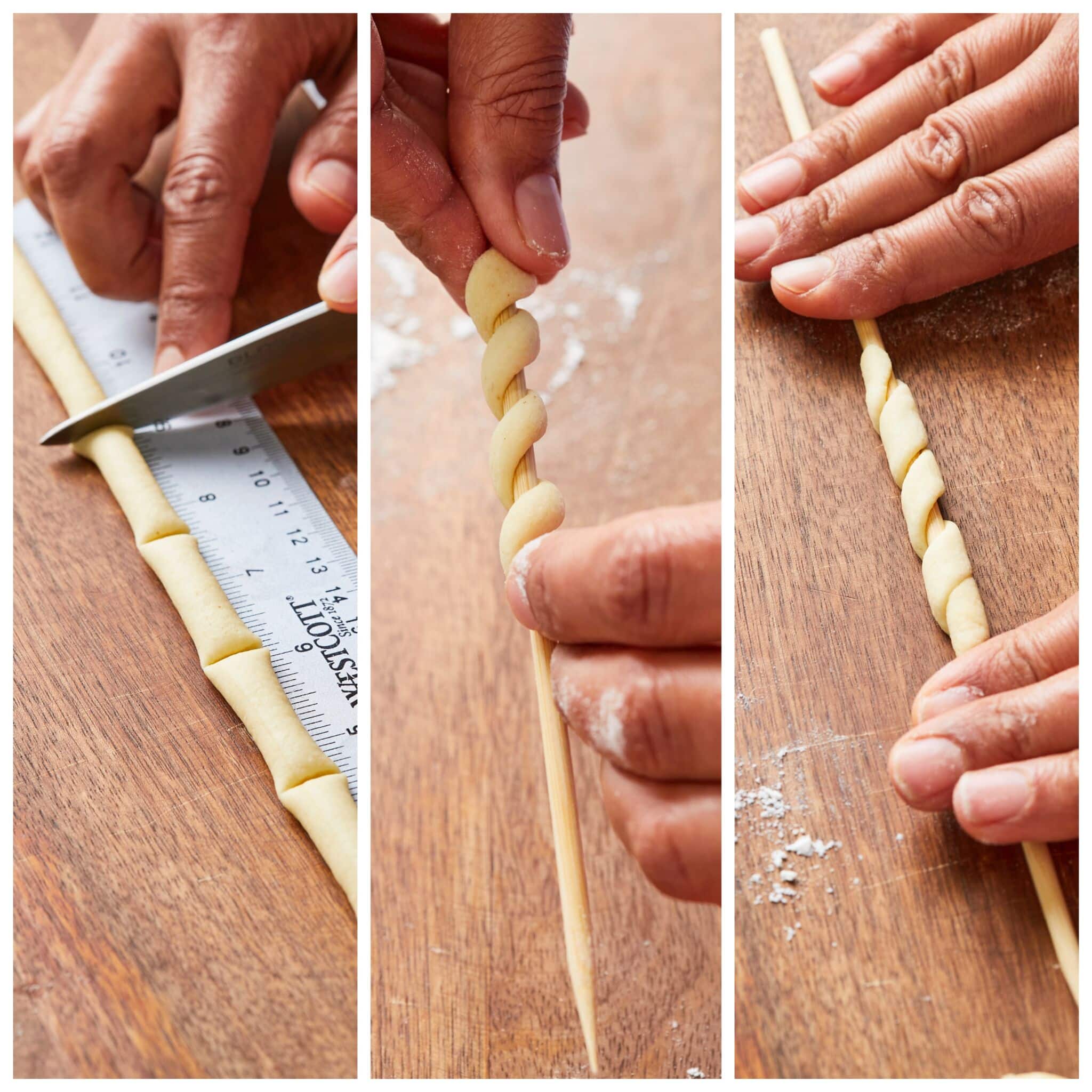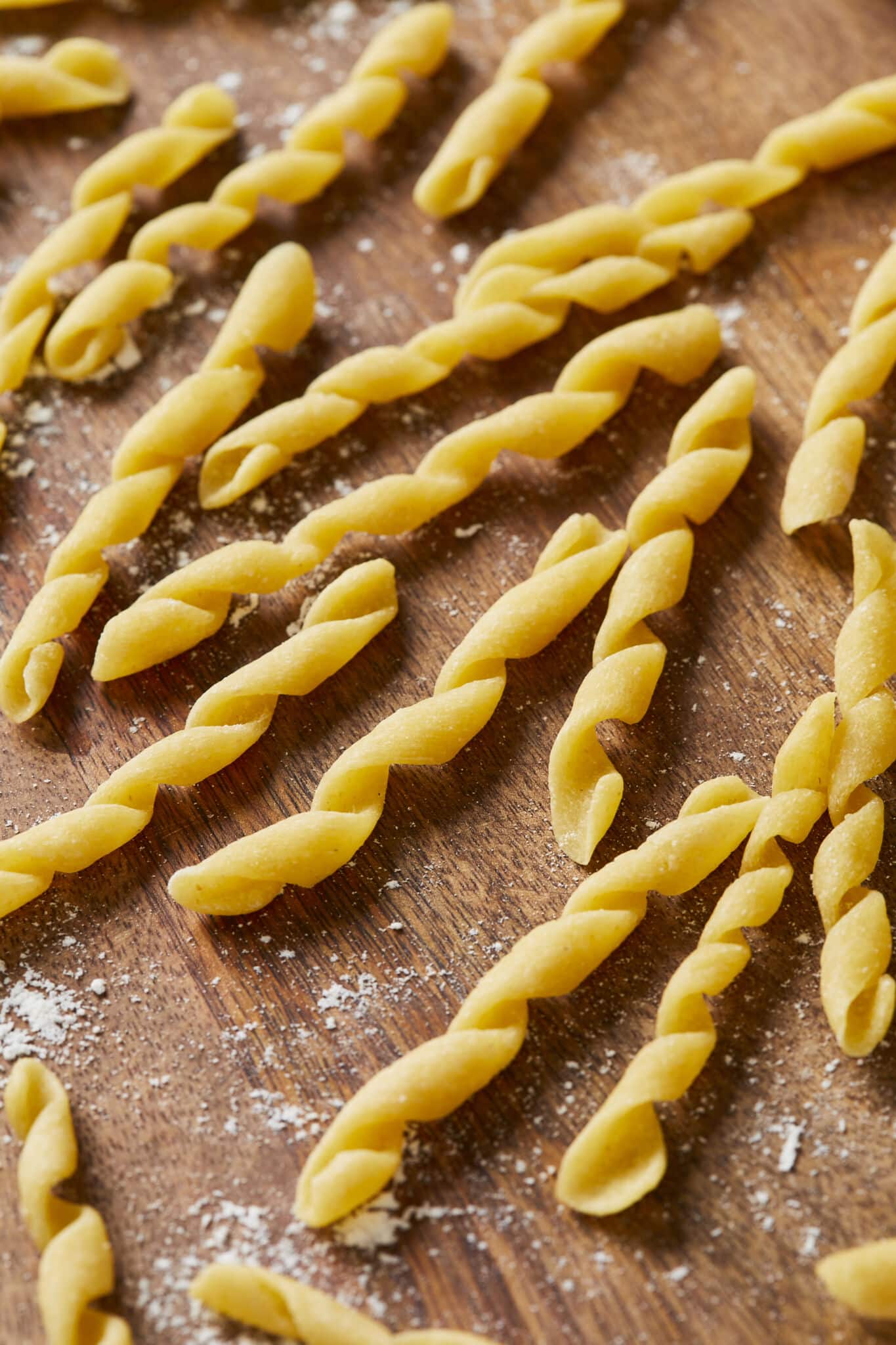Hi Bold Bakers! WHY YOU’LL LOVE THIS RECIPE: Busiate pasta is known for its characteristic cord shape that’s ideal for holding chunky or vegetable-based sauces. As one of the best-loved durum wheat semolina pastas, Busiate pasta enhances every ingredient it embraces with its richly wheaty and lightly nutty taste and a delightful resistance to the bite. Its versatility extends beyond the realm of traditional Sicilian cuisine, seamlessly adapting to various culinary landscapes, and bringing a delightful blend of artistry, texture, and flavor to the table, leaving food enthusiasts craving for more. Already have an account? This Busiate pasta is from my master Semolina Pasta Recipe and I can’t wait to share with you each variation of it! Try out these amazing recipes too: Gnocchetti (ridged small elongated shell), Trofie (twisted pasta), Foglie (olive leaf), Cavatelli (mini hot dog bun), and Orecchiette (small ears).
Table of Contents
What is Busiate Pasta?
Busiate pasta is a traditional type of pasta that originates from Sicily, western Italy. It does not contain eggs. The word “busiate” is originally believed to come from the Sicilian term “buso” which is a local grass with a thick stem that was used to coil the pasta around. Some other people claim it’s derived from the Sicilian term “busa” which means “a twist” or “coil”. This is typically served with a fresh tomato-based Trapanese pesto, made with basil, tomatoes, almonds, garlic, and extra virgin olive oil. (Trapani is a city in western Sicily with a crescent-shaped coastline.)
Tools You Need
Food processor or large bowl Measuring cups and measuring spoons Knife Baking tray Skewer
Key Ingredients and Why
Semolina flour
Semolina flour is made from hard durum wheat, the species of wheat used to make pasta. This high gluten, high protein (13%) content gives durum wheat flour more durability and elasticity in contact with warm water. That helps the pasta keep its shape while cooking and gives your pasta dishes that wonderful al dente texture. It has a coarse, grainy texture, and is pale yellow in color from the carotenoids, the natural pigment found in durum wheat as well as in carrots and sweet potatoes.
How to Make Busiate Pasta
Make the dough from my 2-Ingredient Semolina Pasta Recipe. To shape the pasta: Divide the dough into eighths and work with one portion at a time, leaving the remaining dough covered to keep it from drying out. On a clean, un-floured work surface, roll the dough into a very thin strip about ¼ inch (6 mm) thick. Cut the rope into 3-inch (9 cm) pieces. Working with one piece of dough at a time, twist the dough around a wooden skewer, and then roll the skewer to flatten the coil. Gently slip the dough off the skewer and transfer each piece to a baking tray dusted with semolina to let dry as you continue to shape the rest of the dough.
Dry the pasta: Allow the dough to dry in a single layer on the baking tray for several hours to dry before cooking or transferring to an airtight container for storing at room temperature for up to 8 weeks. (See my note below on ‘How to Dry Fresh Pasta Correctly at Home’) Cook the Pasta: When ready to cook, bring a large pot of water to a rolling boil. Add salt then the pasta and cook until tender and fully cooked through, about 6-10 minutes. Cook time depends on thickness and shape so check for doneness before removing from the pot. Then drain and serve.
Can I Make Busiate Pasta in Advance?
After the pasta is completely air-dried, it can be stored at room temperature in an airtight container for eight weeks.
How to Dry Fresh Pasta Correctly at Home
Drying homemade pasta correctly and thoroughly before storing it away is a very important step: if not done correctly the stored pasta will go moldy. Because it will be held at room temperature and not in the fridge, removing all the moisture is key to ensuring the safety and longevity of your pasta. Start by tossing the pasta with a small amount of semolina to keep the dough from sticking. Next, lay the pasta in a single layer on a baking sheet. You will need to let your pasta completely air-dry. This can take anywhere from 12 to 24 hours or longer, depending on the temperature and humidity of your kitchen. In hot countries, this step can be faster by putting the pasta in the sun, which is what I do.
How to Store Busiate Pasta
Store leftover cooked pasta in the refrigerator for up to three days. Drizzle a little olive oil on the pasta to keep it from sticking. Or allow the dough to dry in a single layer on the baking tray for several hours before transferring to an airtight container for storing at room temperature for up to 8 weeks. Alternatively, freeze raw fresh semolina pasta for up to eight weeks.
What tools can you use to shape Busiate pasta?
To shape Busicate pasta, you can use a thin rod or skewer, a foil-covered pencil, a clean chopstick or drinking straw.
Can I cook the pasta without drying it first?
The drying ensures that the cavatelli will keep its shape while cooking, and it also might be sticky if you try to boil it without drying it first.
Can I use my food dehydrator to dry my Busiate pasta?
Homemade fresh pasta is generally air-dried. However, you should be able to do it in a single layer in an oven or dehydrator at 135°F for about four hours, checking it at two hours to test it. The timing depends on the thickness of the pasta.
How will I know if my pasta is properly cooked?
Cook the pasta until plump and expanded, and the center no longer looks chalky or raw. Just a note that this homemade pasta, once dried takes longer than fresh pasta to cook so just make sure to give it enough time. it can take anywhere from 6 – 10 minutes to cook.
What are other pesto options besides pesto alla Trapanese? You can also pair Busiate pasta with : “classic basil pesto” made with fresh basil leaves, pine nuts, garlic cloves, Parmesan cheese, and olive oil ; “pistachio and mint pesto” made with fresh mint, pistachios, garlic, Pecorino cheese, and olive oil’; or “cilantro and cashew pesto” made with cilantro, roasted cashews, garlic, lime juice, and olive oil. What dishes can Busiate pasta be used in?
Busiate pasta can add textures and a twist to presentations in cold salads, warm soups, or luscious seafood.
“classic basil pesto” made with fresh basil leaves, pine nuts, garlic cloves, Parmesan cheese, and olive oil ; “pistachio and mint pesto” made with fresh mint, pistachios, garlic, Pecorino cheese, and olive oil’; or “cilantro and cashew pesto” made with cilantro, roasted cashews, garlic, lime juice, and olive oil.
Is Busiate pasta suitable for baking? You can use Busiate pasta in savory baking dishes such as casseroles and pasta bakes. But it’s less common in sweet pasta-based desserts. To experiment with using it for sweets, check out my Chocolate Pasta Recipe with Hazelnut Sauce.
Gemma’s Pro Chef Tips
Make the dough from my 2-Ingredient Semolina Pasta Recipe. This dough dries out quite easily so be sure to always keep the dough covered in an airtight container (or in plastic wrap) when you are not working with it. Pasta is usually shaped on an un-floured surface but if you find that your dough sticks too much, try using a very tiny amount of flour. This pasta must dry completely before cooking for it to retain its shape. Even if thoroughly dried, this pasta must be stored in the refrigerator and cooked within two days. Store-bought fresh pasta often cooks in a few minutes but this heartier handmade version can take longer. Be sure to cook thoroughly! Pair this pasta with Roasted Garlic and Herb Compound Butter, Blue Cheese Compound Butter, or Sun-Dried Tomato Compound Butter, you’ll be grand!
More Italian and Sicilian Recipes
Italian Baked Eggs Sicilian Whole Orange Cake Sicilian Eggless Gelato Italian Ricotta Cake with Plums How to Make Ricotta Cheese







